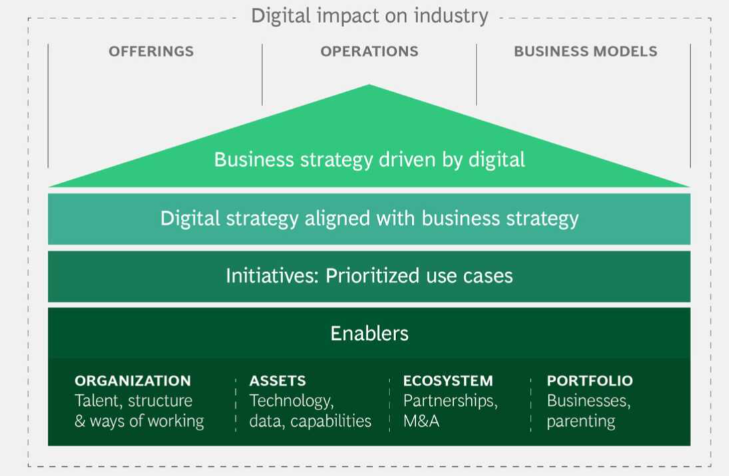Romain de Laubier, Saibal Chakraborty, Simon Rees, Mads Peter Langhorn
Accessed on June 30, 2022
Only 33% of organizations successfully meet the challenge of digital disruption.
Those that do tend to make big strategic bets — on the order of 10% of their market capitalization.
They are rewarded with significant revenue growth and 14 extra points of total shareholder return.
The critical question is this: which strategic bets should you make — and in what order?
The digital strategy roadmap answers those questions in just 8–12 weeks.
Recently recognized by Forrester Research as a leader in digital transformation services, BCG brings strong digital business strategy capabilities and helps you improve your strategic planning to better understand how to layer new technology into business strategy and operations.
Our digital strategy roadmap sets you up for success by laying out the transformation plan, accountabilities, and metrics needed to ensure your results match your aspirations.
Avoiding the Key Pitfalls of Digital Transformation
Most digital transformations start with high aspirations for a step change in performance. Yet most companies never realize those aspirations.
They move through the three key phases of blueprinting the high-level strategy, activating the initiatives and minimum-viable products, and scaling across the organization — and they confront a reality that falls short of their hopes.
In our experience, much of this disappointment can be traced to insufficient rigor in defining the digital strategy during the first phase.
Often organizations lack sharp insight on the key opportunities and threats.
How to Create a Digital Strategy Roadmap
BCG’s digital strategy model is designed to bring necessary rigor to the blueprinting phase. Each digital strategy roadmap engagement is customized to your situation and yields five essential deliverables that answer key questions:
- Digital vision. How is digital changing your industry? What new offerings, operating models, and business models can it enable? What new rivals can it empower?
- Competitive advantage assessment. How is digital affecting competitive advantage? Where are we well positioned? Where are we disadvantaged?
- Prioritized list of digital bets. Which digital opportunities are consistent with your business strategy based on value potential — and with your ambition and capabilities? In what order should you pursue them?
- Gap analysis. Based on your bets, what gaps in capabilities, organization, and systems need to be filled to win?
- Transformation roadmap. What are the timelines, targets, and accountabilities for each of your programs? What moves are needed to fund the journey?
Together, these deliverables create a mutually-supportive and internally-consistent system of choices that embed digital strategy in business strategy — and tie execution tightly to both.

Some examples of Digital Strategy Work
Our digital strategy consultants have worked with hundreds of companies to shape their digital strategies. The starting points varied.
n some cases the focus was on providing a comprehensive roadmap for a full digital transformation. In others, the goal was to define a vision for — and a plan to pursue — the most attractive digital growth opportunities.
And in still others, the mission was to get existing digital transformations back on track, developing a unified strategy to align disparate digital initiatives across divisions and functions.
The Digital Transformation Roadmap to Competitive Advantage
Digital transformation is hard-only 30% of digital transformations succeed in reaching their goals.
But grounding your plans and priorities in clear strategic insight can flip the odds of success from 30% to 80%.
Digital transformation is hard-only 30% of digital transformations succeed in reaching their goals.
But grounding your plans and priorities in clear strategic insight can flip the odds of success from 30% to 80%.
Originally published at https://www.bcg.com.













